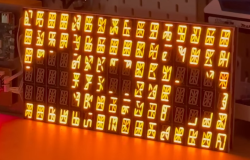When it comes to hacks, the best ones go to extremes. Either beautiful in their simplicity, or magnificent in their excess. And, well, today’s hack is the latter: excessive. [HTX Studio] built an assembly line for origami pigeons!
One can imagine the planning process went something like this:
- Make origami pigeon assembly line
- ?
- Profit
But whatever the motivation, this is an impressive and obviously very well engineered machine. Even the lighting is well considered. It’s almost as if it were made for show…
Now, any self-respecting nerd should know the difference between throughput and latency. From what we could glean from the video, the latency through this assembly line is in the order of 50 seconds. Conservatively it could probably have say 5 birds in progress at a time. So let’s say every 10 seconds we have one origami pigeon off the assembly line. This is a machine and not a person so it can operate twenty four hours a day, save downtime for repairs and maintenance, call it 20 hours per day. We could probably expect more than 7,000 paper pigeons out of this machine every day. Let’s hope they’ve got a buyer lined up for all these birds.
If you’re interested in assembly lines maybe we could interest you in a 6DOF robotic arm, or if the origami is what caught your eye, check out the illuminating, tubular, or self-folding kind!
Continue reading “Building An Assembly Line For Origami Pigeons”




















